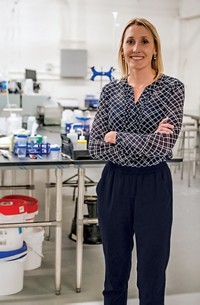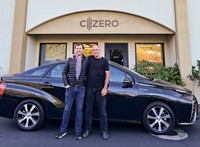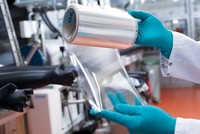×
CEN's 2020 Trailblazers
Paula Hammond: Drug delivery pioneer
Oluwatoyin "Toyin" Asojo: Rare-disease drug hunter
Laura Dassama: Sickle cell fighter
Cordell Hardy: Industrial innovator
Vernon Morris: Atmosphere investigator
Isiah Warner: Materials maestro and mentor
Malika Jeffries-EL: Semiconductor materials maven
Squire Booker: Catalysis champion
Jamel Ali & Patrick Ymele-Leki: Biofilm-busting duo
Carl Bonner: Jack of all chemistries
Cato Laurencin: Tissue regenerator
Kristala Prather: Synthesis warrior
Samson Jenekhe: Polymer powerhouse
Davita Watkins: Supramolecular chemistry sleuth
Karen Akinsanya: Strategic drug discoverer
Lynden Archer: Entrepreneurial educator
Etosha Cave: CO2 converter
Kimberly Jackson: Cancer slayer
Thomas Epps & LaShanda Korley: Upcycling champions
Sherine Obare: Interdisciplinary icon
Historical profiles
Contributors
C&EN's 2020 Trailblazers Celebrating badass women entrepreneurs in chemistry
Advertisement
Grab your lab coat. Let's get started
Welcome!
Welcome!
Create an account below to get 6 C&EN articles per month, receive newsletters and more - all free.
It seems this is your first time logging in online. Please enter the following information to continue.
As an ACS member you automatically get access to this site. All we need is few more details to create your reading experience.
Not you? Sign in with a different account.
Not you? Sign in with a different account.
ERROR 1
ERROR 1
ERROR 2
ERROR 2
ERROR 2
ERROR 2
ERROR 2
Password and Confirm password must match.
If you have an ACS member number, please enter it here so we can link this account to your membership. (optional)
ERROR 2
ACS values your privacy. By submitting your information, you are gaining access to C&EN and subscribing to our weekly newsletter. We use the information you provide to make your reading experience better, and we will never sell your data to third party members.
Climate Change
Movers And Shakers
Etosha Cave wants to turn greenhouse gases into materials we can use
This adventurous engineer wants to convert greenhouse gases into useful materials and chemicals
by Frieda Wiley, special to C&EN
February 22, 2021
| A version of this story appeared in
Volume 99, Issue 6
Etosha Cave’s sense of adventure has taken her to the McMurdo Station in Antarctica to do research and sustained her through cofounding a company in 2015.

Credit: Sarahbeth Maney
Etosha Cave
Etosha Cave
Hometown: Houston
Education: BS, Franklin W. Olin College of Engineering, 2006; MS, 2011, and PhD, 2015, Stanford University
Current position: Cofounder and chief science officer, Opus 12
Fun project she’s been working on: Lots of cooking
Best professional advice she’s received: Spend more time working with your allies than worrying about your enemies.
Cave is the chief science officer of Opus 12, a start-up company specializing in recycling the greenhouse gas carbon dioxide into valuable chemicals. The company’s core technology is based on her PhD research. “We convert carbon dioxide gas into useful products such as plastics, diesel fuel, and household cleaners,” Cave says.
Opus 12 makes reactors that use electricity and water to convert carbon dioxide into useful chemicals; transition-metal catalysts speed up the process. The key to the company’s electrochemical system is a unique ionic polymer membrane electrode. At the reactor’s anode, water is oxidized to generate protons that are transported by the membrane and used in further reactions. The catalyst reduces gaseous CO2 into molecules such as carbon monoxide, methane, and ethylene.
“Our main competitor is the status quo, as in most places it is still free and inconsequential to throw CO2 into the atmosphere,” Cave says. “We also are taking advantage of low-cost renewable electricity, which could make our method of CO2 conversion much cheaper as time goes on.”
Other companies are also striving to transform carbon dioxide into useful materials. Cave says Opus 12’s key advantage is the ionic polymer membranes in its reactors, which allow for high power densities and a robust system design that operates at relatively low temperatures.
Opus 12’s partners include the California utility Pacific Gas and Electric and the luxury vehicle manufacturer Daimler. The company has disclosed $25 million in funding from private sources and grants, though Cave says its capitalization is higher.
Brian Bartholomeusz, executive director of innovation transfer at the TomKat Center for Sustainable Energy at Stanford University, attributes Cave’s success to her drive for innovation and determination in solving real-world problems.
“Etosha’s greatest strength as a researcher has been her consistent search for practical implications of the sometimes esoteric scientific work she is undertaking,” Bartholomeusz says. “I think she has always had one eye focused on what the real impact of her work might be.”
The entrepreneurial engineer traces her beginnings to Houston. She credits her mother, an elementary school science teacher, and her father, a quality-control inspector in the construction industry, for planting the seeds that grew into her passion for problem-solving. At the Booker T. Washington High School for Engineering Professions, Cave found her passion for science and math. “Engineering combined both my parents’ backgrounds and seemed like a natural fit,” she says.
After graduating, she enrolled at Franklin W. Olin College of Engineering, a private institution for engineering based in Needham, Massachusetts, where she was a member of the first graduating class. She felt drawn to the Boston area’s high density of schools. “I wanted to surround myself with all that intellectual power,” she says. “I was also looking for adventure.”
Our main competitor is
the status quo.
the status quo.
Her quest for adventure has remained a constant source of inspiration in the scientist’s life. Before moving to Stanford to start her doctoral program in engineering, she spent 5 months working on an atmospheric chemistry project in Antarctica at the McMurdo Station. In addition to being the trip of a lifetime, the field research also supported her career goals. “Antarctica is one of the analogs of living on Mars, and I’d like to be an astronaut someday,” she says.
She notes that Opus 12’s technology for converting an abundant gas into useful chemicals would be particularly useful on Mars or the moon.
Cave says she fantasizes about retiring to a martian colony one day—the ultimate adventure. “Ninety-five percent of Mars’s atmosphere is CO2,” she says. “I would love for our technology to be featured on a spaceflight.”
Chemical & Engineering News
ISSN 0009-2347
Copyright © 2024 American Chemical Society





Join the conversation
Contact the reporter
Submit a Letter to the Editor for publication
Engage with us on Twitter